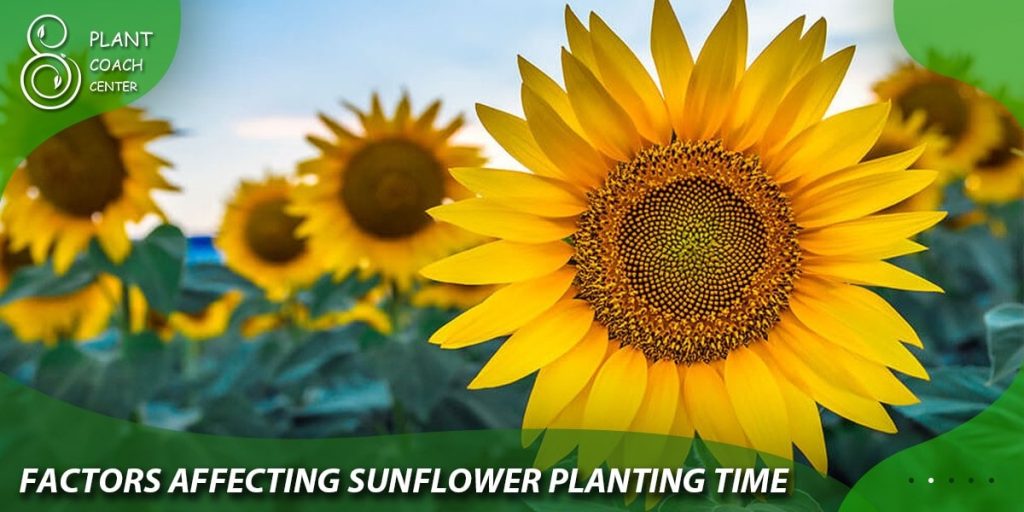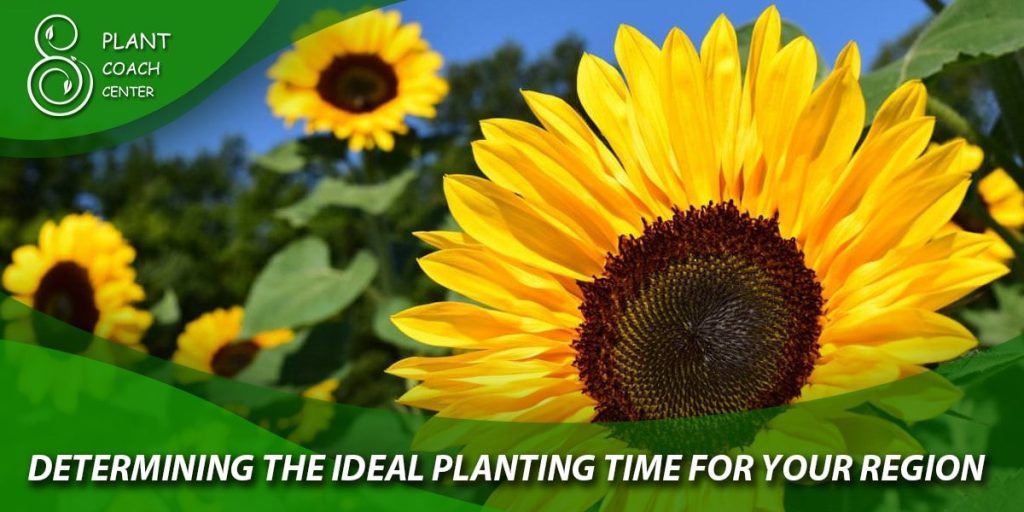When Can I Plant Sunflowers
Sunflowers are a popular and versatile garden plant that can add color, texture, and interest to any landscape. They’re easy to grow, and their large, showy flowers can brighten up any space.
But when is the best time to plant sunflowers? In this comprehensive guide, we’ll explore the factors that affect sunflower planting time, and give you tips for growing healthy, vibrant sunflowers in your own garden.

Introduction to Sunflowers
Sunflowers (Helianthus annuus) are a member of the Asteraceae family of plants, which also includes daisies, asters, and chrysanthemums. They’re native to North and Central America, and have been cultivated for thousands of years for their edible seeds, oil, and ornamental value.
Sunflowers are known for their large, bright yellow flowers, which can range in size from a few inches to over a foot in diameter. They typically bloom in mid- to late summer, and can continue blooming for several weeks.
Benefits of Growing Sunflowers
There are many benefits to growing sunflowers in your garden. Some of the key benefits include:
– Adding color and visual interest to your landscape
– Providing a food source for birds and other wildlife
– Producing edible seeds that can be roasted or used in cooking
– Attracting beneficial insects like bees and butterflies to your garden
Overview of Planting and Growing Requirements
Sunflowers are relatively easy to grow, but they do have some specific planting and growing requirements. Some of the key requirements include:
– Full sun: Sunflowers need at least 6-8 hours of direct sunlight per day to thrive.
– Well-draining soil: Sunflowers prefer soil that is well-draining and rich in organic matter.
– Adequate water: Sunflowers need regular watering, especially during hot, dry weather.
– Fertilizer: Sunflowers benefit from regular fertilization with a balanced fertilizer or compost tea.
– Pest and disease management: Sunflowers can be vulnerable to pests like aphids and diseases like powdery mildew, so it’s important to monitor your plants regularly and take action as needed.
Now that we’ve covered the basics of sunflower planting and growing requirements, let’s take a closer look at the factors that affect sunflower planting time.

Factors Affecting Sunflower Planting Time
The ideal time to plant sunflowers will depend on a variety of factors, including climate, soil conditions, sunflower variety, and length of growing season. Let’s take a closer look at each of these factors.
Climate and Weather Patterns
Sunflowers are sensitive to frost, so it’s important to time your planting so that your plants are well-established before the first frost of the season. The timing of the first frost will depend on your location, so be sure to check with your local weather service or agricultural extension office to determine your average frost date.
In general, sunflowers should be planted after the last frost of the season and before the soil temperature reaches 60°F (15°C). If you live in a cooler climate, you may need to wait until late spring or early summer to plant your sunflowers.
Soil Temperature and Conditions
Sunflowers prefer warm soil, so it’s important to wait until the soil temperature has reached at least 50°F (10°C) before planting your seeds. You can use a soil thermometer to determine the temperature of your soil.
In addition to soil temperature, sunflowers also prefer soil that is well-draining and rich in organic matter. Before planting, be sure to amend your soil with compost or other organic matter to improve its structure and fertility.
Sunflower Variety and Maturity Rate
Different sunflower varieties have different maturity rates, so it’s important to choose a variety that is well-suited to your growing conditions and desired harvest time. Some sunflower varieties can mature in as little as 60 days, while others may take up to 120 days or more.
When selecting a sunflower variety, consider factors like height, flower size, and petal color as well as maturity rate. You may also want to consider whether you want to harvest sunflower seeds for eating or for planting.
Length of Growing Season
The length of your growing season will also play a role in determining the best time to plant sunflowers. If you have a short growing season, you may need to choose a sunflower variety with a shorter maturity rate or plant earlier in the season to ensure that your plants have enough time to mature before the first frost.
On the other hand, if you have a longer growing season, you may be able to plant later in the season and still achieve a good harvest.

Determining the Ideal Planting Time for Your Region
Now that we’ve covered the factors that affect sunflower planting time, let’s take a closer look at how to determine the ideal planting time for your region.
Determining Your Local Frost Dates
The first step in determining your ideal sunflower planting time is to determine your average frost date. This will give you a good idea of when the season typically ends in your area, and when you should aim to have your sunflowers planted.
To determine your average frost date, you can check with your local weather service or agricultural extension office. They should be able to provide you with information on when the first and last frosts typically occur in your area.
Timing Your Planting Based on Frost Dates and Other Factors
Once you know your average frost date, you can work backwards to determine the best time to plant your sunflowers. In general, you’ll want to plant your sunflowers at least 2-3 weeks before your average frost date to give them time to mature before the first frost.
However, you’ll also need to take into account other factors like soil temperature, sunflower variety, and length of growing season. If you have a short growing season, for example, you may want to plant earlier in the season to ensure that your plants have enough time to mature. If you have a longer growing season, you may be able to plant later in the season and still achieve a good harvest.
Choosing the Best Location for Planting
In addition to timing your planting, it’s also important to choose the best location for planting your sunflowers. Sunflowers prefer full sun and well-draining soil, so be sure to choose a location that gets plenty of direct sunlight and has soil that is rich in organic matter.
You may also want to consider factors like wind protection and proximity to other plants. Sunflowers can be quite tall and may need support to prevent them from bending or breaking in strong winds. And if you’re planting sunflowers near other plants, be sure to give them enough space to avoid crowding and competition for nutrients.
Now that we’ve covered the basics of sunflower planting time and how to determine the ideal planting time for your region, let’s move on to preparing for sunflower planting.

Preparing for Sunflower Planting
Before you start planting your sunflowers, it’s important to prepare your soil and choose the right location for planting. Here are some tips for preparing your soil and getting your garden ready for sunflower planting.
Soil Preparation Techniques
Sunflowers prefer soil that is well-draining and rich in organic matter. Before planting, be sure to amend your soil with compost or other organic matter to improve its structure and fertility.
You can also add a balanced fertilizer or compost tea to provide additional nutrients for your sunflowers. Be sure to follow the manufacturer’s instructions for application rates and timing.
If your soil is heavy or poorly draining, you may need to take additional steps to improve its structure. This may include adding sand or perlite to improve drainage, or creating raised beds to improve soil aeration.
Soil Testing and Nutrient Requirements
Before planting, it’s a good idea to test your soil to determine its pH and nutrient levels. You can purchase a soil test kit from your local garden center or agricultural extension office, or you can send a soil sample to a soil testing laboratory for analysis.
Based on the results of your soil test, you can adjust your soil pH and add the appropriate nutrients to ensure that your sunflowers have everything they need to grow and thrive.
Choosing the Right Location for Planting
Sunflowers prefer full sun and well-draining soil, so be sure to choose a location that gets at least 6-8 hours of direct sunlight per day and has soil that is rich in organic matter.
You may also want to consider factors like wind protection and proximity to other plants. Sunflowers can be quite tall and may need support to prevent them from bending or breaking in strong winds. And if you’re planting sunflowers near other plants, be sure to give them enough space to avoid crowding and competition for nutrients.
Adding Organic Matter to the Soil
Adding organic matter to your soil can improve its structure, fertility, and water-holding capacity. Some good sources of organic matter include compost, well-rotted manure, and leaf mold.
To add organic matter to your soil, simply spread a layer of compost or well-rotted manure over the surface of your soil and work it in with a garden fork or tiller. You can also add a layer of organic mulch, such as shredded leaves or straw, to help retain moisture and suppress weeds.
By taking the time to prepare your soil and choose the right location for planting, you can give your sunflowers the best possible start and ensure that they grow strong and healthy.
In the next section, we’ll take a closer look at how to plant sunflower seeds and give you tips for ensuring successful germination and growth.
Planting Sunflower Seeds
Now that you’ve prepared your soil and chosen the right location for planting, it’s time to start planting your sunflower seeds. Here are some tips for planting sunflower seeds and ensuring successful germination and growth.
Seed Selection and Preparation
When selecting sunflower seeds, be sure to choose a variety that is well-suited to your growing conditions and desired harvest time. Some sunflower varieties can mature in as little as 60 days, while others may take up to 120 days or more.
To prepare your sunflower seeds for planting, you can soak them in water overnight to help soften the seed coat and improve germination rates. You can also scarify the seed coat with sandpaper or a file to help the seedlings emerge more easily.
Planting Techniques and Tips
When planting your sunflower seeds, be sure to follow these planting techniques and tips for best results:
– Plant your seeds at a depth of 1-2 inches (2.5-5 cm) and space them 6-12 inches (15-30 cm) apart, depending on the variety.
– Water your seeds after planting to ensure that the soil stays moist but not waterlogged.
– Cover your seeds with a layer of mulch or straw to help retain moisture and suppress weeds.
– If you’re planting a large area, consider using a seed drill or planter to help ensure even spacing and planting depth.

Germination and Growth
Sunflowers typically germinate within 7-10 days under optimal conditions. To promote healthy growth and development, be sure to provide your sunflowers with the following:
– Full sun: Sunflowers need at least 6-8 hours of direct sunlight per day to thrive.
– Adequate water: Sunflowers need regular watering, especially during hot, dry weather.
– Fertilizer: Sunflowers benefit from regular fertilization with a balanced fertilizer or compost tea.
– Pest and disease management: Sunflowers can be vulnerable to pests like aphids and diseases like powdery mildew, so it’s important to monitor your plants regularly and take action as needed.
Supporting Your Sunflowers
As your sunflowers grow, they may need support to prevent them from bending or breaking in strong winds. You can support your sunflowers by staking them with bamboo or wooden stakes, or by using a trellis or other support structure.
Be sure to tie your sunflowers to the support structure loosely with twine or plant ties, to avoid damaging the stems or restricting growth.
Harvesting Sunflower Seeds
One of the most rewarding aspects of growing sunflowers is harvesting the seeds for eating or for planting. Here are some tips for harvesting sunflower seeds and ensuring that they’re ready for consumption or planting.
Harvesting Techniques and Tips
When harvesting sunflower seeds, be sure to follow these harvesting techniques and tips for best results:
– Wait until the flowers have fully matured and the petals have fallen off.
– Cut the flower head off the stem with a sharp knife or pruners.
– Hang the flower head upside down in a warm, dry place to allow the seeds to dry and cure.
– Once the seeds are dry, remove them from the flower head by rubbing them with your hands or using a fork or comb.
– Store the seeds in an airtight container in a cool, dry place.
Roasting and Eating Sunflower Seeds
Sunflower seeds can be roasted and eaten as a healthy and delicious snack. To roast sunflower seeds, follow these simple steps:
– Preheat your oven to 300°F (150°C).
– Spread the seeds in a single layer on a baking sheet.
– Roast the seeds for 30-40 minutes, stirring occasionally, until they’re golden brown and fragrant.
– Remove the seeds from the oven and allow them to cool before eating.
Roasting and Eating Sunflower Seeds
Conclusion
Sunflowers are a beautiful and versatile garden plant that can add color, texture, and interest to any landscape. By following the tips and techniques outlined in this guide, you can successfully plant, grow, and harvest sunflowers in your own garden.
So get out there and start planting – you’ll be amazed at the beauty and bounty that sunflowers can bring to your garden!
When should I plant sunflowers?
Plant sunflowers after the last frost date in your area, typically in late spring or early summer when the soil has warmed up.
How much sunlight do sunflowers need?
Sunflowers are sun-loving plants and require full sun to thrive. They need at least 6 to 8 hours of direct sunlight per day.
How far apart should I plant sunflower seeds?
For most varieties, plant sunflower seeds about 6 to 12 inches (15 to 30 cm) apart, depending on the size of the mature plant.







